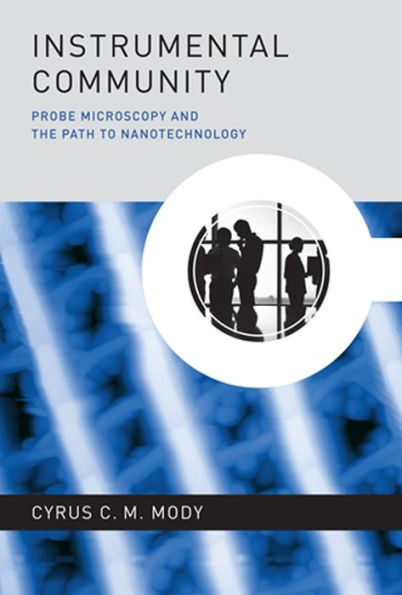
Instrumental Community: Probe Microscopy and the Path to Nanotechnology
280
Instrumental Community: Probe Microscopy and the Path to Nanotechnology
280eBook
Related collections and offers
Overview
The scanning tunneling microscope (STM) has been hailed as the “key enabling discovery for nanotechnology,” the catalyst for a scientific field that attracts nearly $20 billion in funding each year. In Instrumental Community, Cyrus Mody argues that this technology-centric view does not explain how these microscopes helped to launch nanotechnology—and fails to acknowledge the agency of the microscopists in making the STM and its variants critically important tools. Mody tells the story of the invention, spread, and commercialization of scanning probe microscopy in terms of the networked structures of collaboration and competition that came into being within a diverse, colorful, and sometimes fractious community of researchers. By forming a community, he argues, these researchers were able to innovate rapidly, share the microscopes with a wide range of users, and generate prestige (including the 1986 Nobel Prize in Physics) and profit (as the technology found applications in industry).
Mody shows that both the technology of probe microscopy and the community model offered by the probe microscopists contributed to the development of political and scientific support for nanotechnology and the global funding initiatives that followed. In the course of his account, Mody charts the shifts in U.S. science policy over the last forty years—from the decline in federal basic research funding in the 1970s through the rise in academic patenting in the 1980s to the emergence of nanotechnology discourse in the 1990s—that have resulted in today's increasing emphasis on the commercialization of academic research.

Product Details
| ISBN-13: | 9780262297240 |
|---|---|
| Publisher: | MIT Press |
| Publication date: | 10/21/2011 |
| Series: | Inside Technology |
| Sold by: | Penguin Random House Publisher Services |
| Format: | eBook |
| Pages: | 280 |
| File size: | 12 MB |
| Note: | This product may take a few minutes to download. |
About the Author
What People are Saying About This
The title is just right: Mody invites us to consider—at once and in the same frame—innovation in a scientific and technological instrument and innovation in organizational forms. The one gives practitioners astounding abilities to represent and intervene at micro-levels; the other permits them to extend the institutional environments in which the instrument can thrive. Instrumental Community is a major achievement.
This original and absorbing book brings into focus the mutual development of a new instrument—the scanning tunneling microscope—and its community of users. Paying close attention to both technical details and social dynamics, Mody offers keen insights on the interfaces between research and commerce, science and engineering, and the genesis of nanotechnology. A story of applied science in action.
In Instrumental Community, Cyrus Mody provides one of the richest analyses to date of the ways a new tool becomes an obligatory instrument—and how the instrument and its users evolve in tandem. Like the powerful microscopes at the center of this story, Instrumental Community reveals surprising structures and craggy interfaces: between academic disciplines, corporate laboratories, and heterogeneous networks of researchers; scientific research and commercialization; and hype and hope in the crystallization of nanotechnology. A remarkable achievement.
—David Kaiser, author of Drawing Theories Apart and How the Hippies Saved Physics
The title is just right: Mody invites us to consider—at once and in the same frame—innovation in a scientific and technological instrument and innovation in organizational forms. The one gives practitioners astounding abilities to represent and intervene at micro-levels; the other permits them to extend the institutional environments in which the instrument can thrive. Instrumental Community is a major achievement.
—Steven Shapin, Franklin L. Ford Professor of the History of Science, Harvard UniversityThis original and absorbing book brings into focus the mutual development of a new instrument—the scanning tunneling microscope—and its community of users. Paying close attention to both technical details and social dynamics, Mody offers keen insights on the interfaces between research and commerce, science and engineering, and the genesis of nanotechnology. A story of applied science in action.
—Angela N. H. Creager, Princeton UniversityIn Instrumental Community, Cyrus Mody provides one of the richest analyses to date of the ways a new tool becomes an obligatory instrument—and how the instrument and its users evolve in tandem. Like the powerful microscopes at the center of this story, Instrumental Community reveals surprising structures and craggy interfaces: between academic disciplines, corporate laboratories, and heterogeneous networks of researchers; scientific research and commercialization; and hype and hope in the crystallization of nanotechnology. A remarkable achievement.
—David Kaiser, author of Drawing Theories Apart and How the Hippies Saved PhysicsIn Instrumental Community, Cyrus Mody provides one of the richest analyses to date of the ways a new tool becomes an obligatory instrument—and how the instrument and its users evolve in tandem. Like the powerful microscopes at the center of this story, Instrumental Community reveals surprising structures and craggy interfaces: between academic disciplines, corporate laboratories, and heterogeneous networks of researchers; scientific research and commercialization; and hype and hope in the crystallization of nanotechnology. A remarkable achievement.
